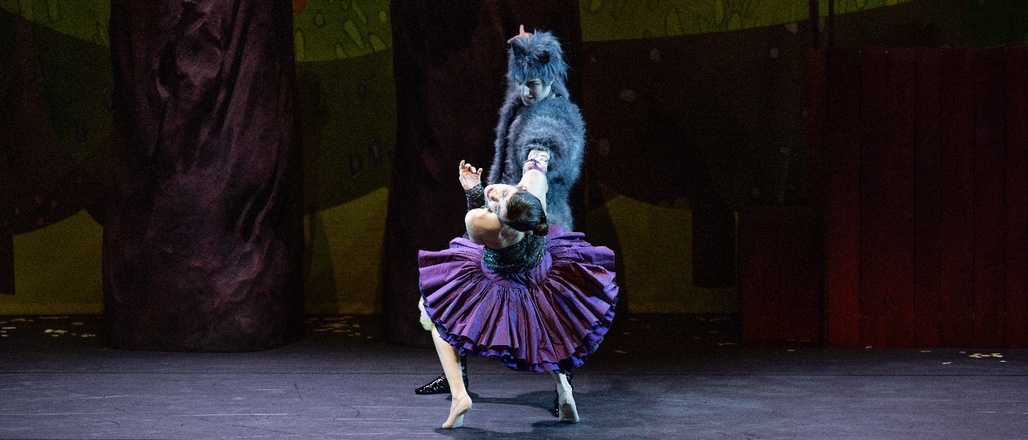Magic and reality
Ballet |
Ballet director and chief choreographer Martin Schläpfer dedicates a world premiere to what is probably the most famous musical fairy tale - Sergei Prokofiev's Peter and the Wolf - and creates a ballet for the whole family with the dancers of the youth company.
Please note: Due to high demand, there will be additional performances at NEST on January 29 and 30 at 3 pm. Get your tickets now!
The work Peter and the Wolf is firmly anchored in the cultural memory of many people. What were your first thoughts on creating a ballet?
Martin Schläpfer: If you want to educate young people musically, Peter and the Wolf belongs in the repertoire. It's a great composition and Prokofiev's drawing of the characters is brilliant. So when I was asked if I would create something for NEST and the youth company, this composition immediately came to mind. The work has magic, it's a fairy tale, but it also has a lot of reality in it. Of course, the text raises a number of questions: What does the generational conflict between Peter and his grandfather mean? How do you deal with the depiction of the animals? I don't want to break with the character drawings, but I don't want to dress them up too cosmetically either. Yes, they are animal figures, but they are still dancers. It was important to me to be physical in the dance language and to give each figure its own gait - muscular and textural. Another challenge is that the musical and text sequences are very short. A lot of action happens in a short space of time, which is charming. It is great fun to work on Peter and the Wolf. It is a play for children, but should not exclude adults.
How did you deal with the text?
Martin Schläpfer: I am always inspired by texts within a musical template. They were also helpful for Peter and the Wolf. The character of the narrator and how he conveys the text to the children is also very important. I believe that the young audience will listen carefully, even if their eyes may remain on the stage. I choreograph the text, also in the rhythm in which it is partly laid out. Then I let it stand on its own elsewhere and it is only carried by the power of the speaker. Sometimes I react to a word, to the meaning of the word. I don't want to choreograph the text, but it is definitely music.
How do you define the role of the speaker?
Martin Schläpfer: I've already thought about staging the speaker, moving him around the space, but ultimately he's on his own - sitting down. I can imagine him interacting with the ensemble at some point, but that won't be decided until the final rehearsals. I liked the idea of having the narrator anchored somewhere, also because the space on stage is already limited and we want to portray a large world: Pond, forest, meadow, garden gate. These are all important elements in the play. I find it exciting to explore how the different levels come together without them being interwoven.
In your ballet, you don't draw the characters in black and white. How did you approach the design of the characters?
Martin Schläpfer: I thought a lot about the characters because the text also has some "traps". Do you want to portray the wolf as so evil and end up taking him to the zoo? For me, it's very strange that the wolf is said to be so terrible. In our production, it wears the most beautiful materials, is noble and respectable. He is more of an enchanted animal, has beauty and dignity, but also darkness. Peter, on the other hand, is a courageous boy who is self-confident and nature-oriented. So it makes sense that he is in dialog with the animals. The cat is Peter's pet in my creation, and the conflict between the bird and the duck is also exciting. It's interesting that we tend to see something Apollonian in a bird and assign a certain ugliness to the duck. I try to avoid that. The grandfather is danced by senior artist Yuko Kato. I wanted to cast someone older in this role because I don't want to disguise the character, I don't want to make someone young look old. The hunters are played by a female dancer and a male dancer. In this pas de deux, the dancer wears pointe shoes and turns them into a "rifle". The pointe shoe can also be a weapon, something hard in all its beauty.
Did you approach the creation differently knowing that it was a piece for children?
Martin Schläpfer: I don't think you have to think differently because it's a children's play. Children are highly intelligent and can put up with things. In the case of Peter and the Wolf, the material is in itself suitable for children. You don't have to trivialize anything, it's still a ballet of mine. The physicality, athleticism and modernity of the movement style meet more naive, purer moments that are effective for children and go straight to the heart. For example, when the cat runs away from the wolf, these are natural movements. It is not choreographed, one chases, one runs away.
This is your second time creating for the youth company. What does the collaboration with the young dancers mean?
Martin Schläpfer: It's a wonderful experience and a great pleasure. The dancers are curious, react directly and intuitively. Of course, it takes a little more time because there is still a kind of pedagogy behind it. I don't have to tell a soloist certain things, but someone who is only 18 years old and is hearing some things for the first time may need a different approach. But that doesn't make the work any less profound than with experienced artists.
The questions were asked by Nastasja Fischer.
